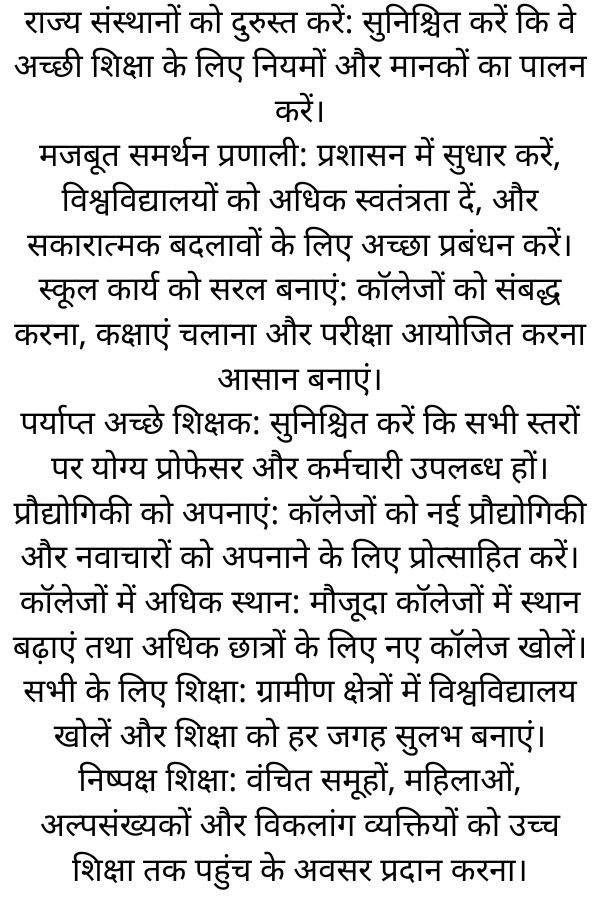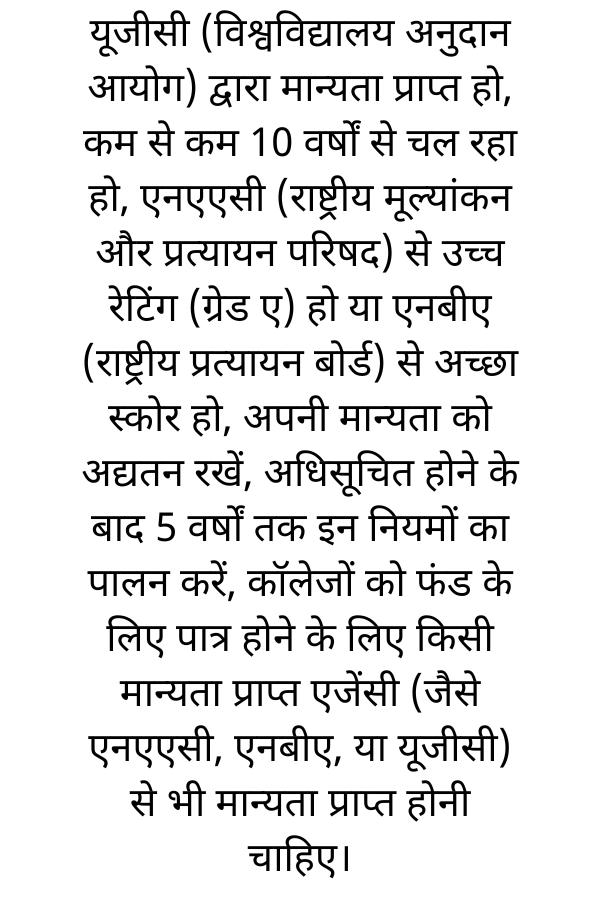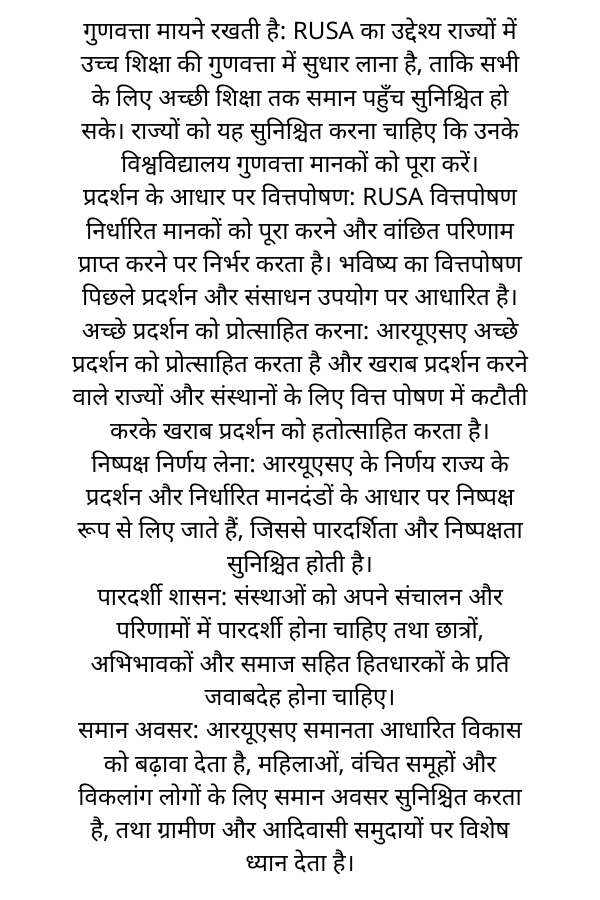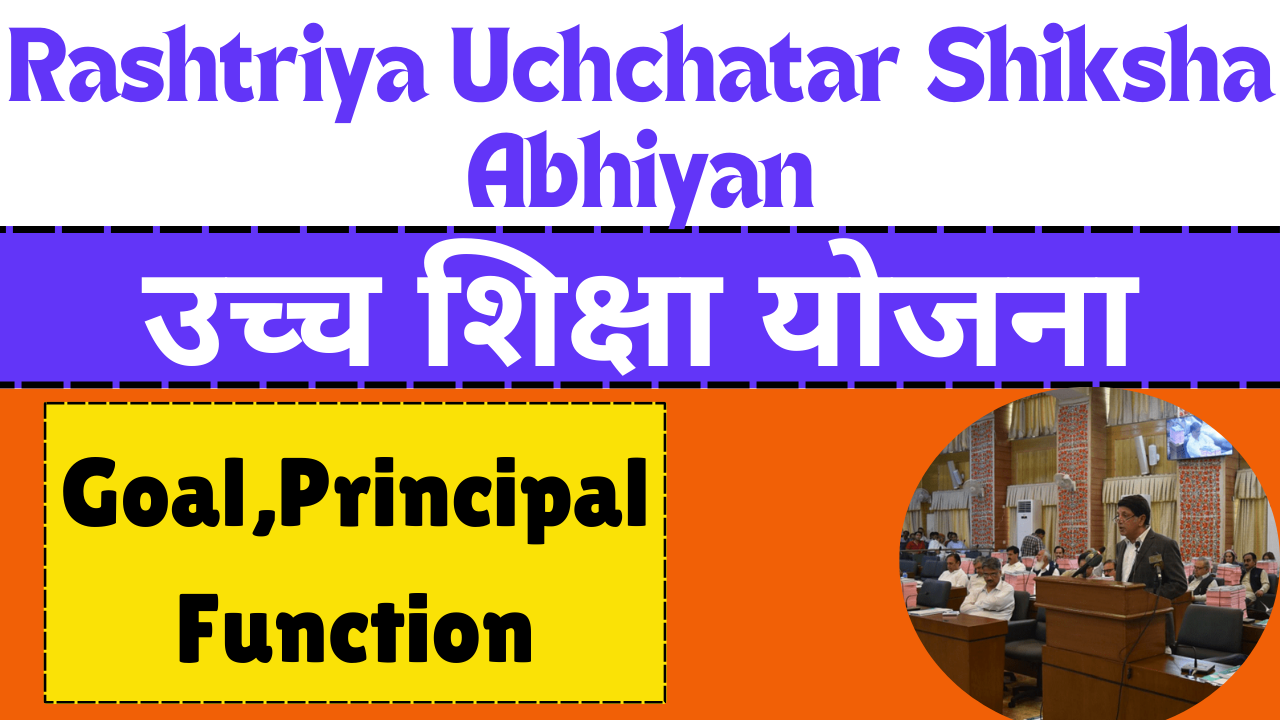The Indian government’s Rashtriya Uchchatar Shiksha Abhiyan (RUSA) helps state universities grow. India’s future depends on giving these universities what they need to help students learn, grow, and think creatively. RUSA knows that some important skills are learned outside the classroom.
This Rashtriya Uchchatar Shiksha Abhiyan initiative stresses that every institution can enrich lives through exceptional education, whether it involves:Deploying advanced university management systems Enhancing libraries (adopting state-of-the-art library automation) and research facilities Empowering self-governing colleges Consolidating colleges to harness their collective potential and form a network of universities.
hindi yojana newsGoals of RUSA
- Make education more accessible: Help more people from disadvantaged groups join universities.
- Make education fairer: Reduce differences in opportunities for higher education.
- Improve education quality: Raise academic standards and research capabilities.
- Prepare students for jobs: Help graduates develop skills that make them employable.
Objectives of RUSA
- Fix State Institutions: Make sure they follow rules and standards for good education.
- Strong Support System: Improve administration, give universities more freedom, and manage well for positive changes.
- Simplify School Work: Make it easier to affiliate colleges, run classes, and conduct exams.
- Enough Good Teachers: Ensure qualified professors and staff are available at all levels.
- Embrace Technology: Encourage colleges to adopt new technology and innovations.
- More Space in Colleges: Add space in existing colleges and open new ones for more students.
- Education for All: Open universities in rural areas and make education accessible everywhere.
- Fair Education: Provide opportunities for disadvantaged groups, women, minorities, and differently-abled individuals to access higher education.

RUSA Funding
Rashtriya Uchchatar Shiksha Abhiyan gives money to state higher education institutes to help them improve. This money is given based on rules and results. The amount of money each state gets depends on its category:
- Special category states: 90% from RUSA, 10% from the state
- General category states: 60% from RUSA, 40% from the state
- Union Territories: 100% from RUSA
Before the money reaches the colleges, it goes through:
- Central ministry
- State government or Union Territory
- State higher education council
Each state makes a plan (State Higher Education Plan) explaining how it will improve higher education and make it fair for all. This plan helps decide how much money each state gets.
Eligiblity Criteria
- Be recognized by the UGC (University Grants Commission)
- Have been running for at least 10 years
- Have a high rating (Grade A) from NAAC (National Assessment and Accreditation Council) or a good score from NBA (National Board of Accreditation)
- Keep their accreditation up to date
- Follow these rules for 5 years after they’re notified
- Colleges must also get accredited by a recognized agency (like NAAC, NBA, or UGC) to be eligible for funds.

RUSA aims to
- Establish new universities by elevating current self-governing colleges and consolidating institutions into networks.
- Launch innovative degree-granting colleges and specialized institutions, and enhance facilities and resources for colleges and universities.
- Provide assistance in faculty hiring, faculty development initiatives, and leadership training for educational administrators.
- Integrate the core plan of Polytechnics to enhance skill development.
- Combine vocational courses with higher education.
- Promote reforming, reorganizing, and strengthening institutions in member governments.
The primary components of RUSA include:
- Upgrading existing colleges to universities
- Merging colleges into cluster universities
- Providing infrastructure grants to universities
- Establishing New Model Colleges (General and Professional)
- Upgrading existing degree colleges to model colleges
- Providing infrastructure grants to colleges
- Fostering research, innovation, and quality improvement
- Implementing equity initiatives
- Supporting faculty recruitment
- Enhancing faculty capabilities
- Integrating vocational training with higher education
- Developing leadership skills for educational administrators
- Restructuring and reforming institutions
- Building capacity and preparing for data collection and planning
principles of RUSA
- Quality Matters: Rashtriya Uchchatar Shiksha Abhiyan aims to improve the quality of higher education in states, ensuring equal access to good education for all. States must ensure their universities meet quality standards.
- Funding Based on Performance: Rashtriya Uchchatar Shiksha Abhiyan funding depends on meeting set standards and achieving desired outcomes. Future funding is based on past performance and resource utilization.
- Encouraging Good Performance: Rashtriya Uchchatar Shiksha Abhiyan incentivizes good performance and discourages poor performance by reducing funding for underperforming states and institutions.
- Unbiased Decision Making: Rashtriya Uchchatar Shiksha Abhiyan decisions are made impartially, based on state performance and set metrics, ensuring transparency and fairness.
- Transparent Governance: Institutions must be transparent in their operations and outcomes, accountable to stakeholders, including students, parents, and society.
- Equal Opportunities: Rashtriya Uchchatar Shiksha Abhiyan promotes equity-based development, ensuring equal opportunities for women, underprivileged groups, and those with disabilities, with a focus on rural and tribal communities.

Functions of RUSA
- Track Money and Info: Monitor how funds and information are flowing.
- Review State Education Plans: Look at and give feedback on State Higher Education Plans and work with State Higher Education Councils.
- Manage Data System: Work with the data system provider to plan, coordinate, and manage the system.
- Make Data Reports: Create reports from the data system as needed.
- Support Project Teams: Give operational, technical, logistical, and managerial support to project teams.
- Do Evaluation Studies: Conduct studies to evaluate the project’s progress.
- Hire Consultants: Appoint experts to help with project monitoring, design, technical input, and other tasks as needed.
- Review State Project Plans: Look at and recommend state project plans to the Central Government for funding.
- Check Fund Use: Monitor how states use funds to achieve targets and timelines.
Rashtriya Uchchatar Shiksha Abhiyan upsc
Rashtriya Uchchatar Shiksha Abhiyan is an important topic for UPSC exams that aims to improve higher education in India. Remember these key points:
- When it started and what it wants to achieve
- Focus on fairness, access, and excellence
- Goals like better quality, independence, and new ideas
- Shared funding between central and state governments
- Implemented through state-level education councils and departments
Knowing these points will help you answer Rashtriya Uchchatar Shiksha Abhiyan -related questions in UPSC exams, especially in papers about education, social welfare, and governance. Stay informed and confident to do your best in the exams!
RUSA in English
Rashtriya Uchchatar Shiksha Abhiyan (RUSA) is a national program to improve higher education in India. It was started in 2013 by the Ministry of Education, Government of India. The program aims to make higher education better and more accessible to all.
FAQs
Who founded Rusa?
What is the mission of RUSA ?
What is the education policy in India?
3 years of preschool (ages 3-6)
A new way of structuring school:
5 years of primary school
3 years of upper primary school
3 years of high school
4 years of higher education
Who is the father of education in India?
Shaping India’s education system ,Building important educational institutions
Still have more questions About Rashtriya Uchchatar Shiksha Abhiyan?
If you have any further questions, we are here to serve you. Join the WhatsApp channel by clicking on the button below. Visit our website on daily basis. Our website hindiyojananews.net provides complete details of all the schemes launched by the Indian Government. You can find complete details about all these schemes released by the Indian government on our website Our Website Not A Official Site. We Provide Just Latest News Update About Social Schemes !

